Blister Card Printing Solutions
Blister card printing of up to 10" wide blister cards can be done using our ThermaPrint64 label printer. Various thickness are also supported ~0.040″ being the thickest standard card.
BLISTER CARD PRINTERS#
Blister cards have long been a staple of the packaging industry, used to package everything from electronics to medicines. Blister card printing, similarly, has long been a requirement of many commercial printers.
Making your own blister packs can be difficult. Typically, print orders for blister cards are of extremely large volume, but also require that each card printed include unique content. This might be a serial number, for instance, or a bar-code. To make matters worse, often an order includes several different items, and therefore several different designs will need to be printed.
In addition, many clients are keen to make their packaging stand out, and therefore value the option of different fonts, shapes, and layout for their blister cards.
Blister card printers today, thankfully, are up to this task. They are high-tech machines which are specifically designed to deal with the requirements of even the most demanding of customers.
HOW BLISTER CARD PRINTERS WORK#
The process of blister card printing requires a few stages. First, the card stock is loaded into a printer’s feed mechanism, either as pre-cut cards or as a continuous roll. This substrate is then fed to the printer via a powered feeder which is normally integrated into the printing system. The advantage of using a powered feeder over one operated by gravity alone, and the reason this has become standard for blister card printing, is that a much faster printing rate may be achieved in this way.
Industrial blister pack printers usually use thermal printing techniques, as this offers the best mix of print quality and speed. With the most modern blister card printers, resolutions of 300 DPI and above are achievable, ensuring that the client’s design is faithfully reproduced. These printers are also able to print right to the edge of the blister card.
The printer’s integrated computer is typically in control of printing each label. After being programmed, this computer is then able to add unique content to each blister card, normally adding a product serial number and a bar-code, though in some cases also adding more variation.
After printing, the system will cut the blister card into shape, if this is required. It will then deposit the finished, printed card into an output tray. For very large orders, some systems also incorporate a powered, automated sorting mechanism, which precisely stacks the printed blister cards according to size or design.
WHAT TO LOOK FOR IN BLISTER CARD PRINTERS#
When looking for a blister card printer, be aware of your own requirements, and the types of orders you generally receive. In general, however, there are some key features to look for in this type of printer:
One of the most important considerations is speed. Blister card print orders are often of very high volume, and so a printing speed of at least 5 inches/second is a must. In addition, some modern printers now have a slew capability, allowing them to quickly skip over non-printed sections of the card, greatly improving overall speed.
Print quality should also be a major consideration. Often, blister cards require that very small writing be reproduced precisely, and this is of special concern in the health-care sector. Nowadays, the best blister card printers are able to print at up to 300 DPI, which is more than sufficient for these purposes.
If you are dealing with extremely large orders, an automated and motorized sorting module is also extremely useful. In many cases, an order for blister cards will contain several varying types or sizes of package, and a motorized sorter means that each type will be automatically stacked in the correct pile.
Last but not least, of course, the ruggedness of the printer should be assessed. Blister card printers, like a lot of industrial printers, often need to work reliably in quite difficult environments, and the printer should be able to deal with heat, dust, and other complications.
